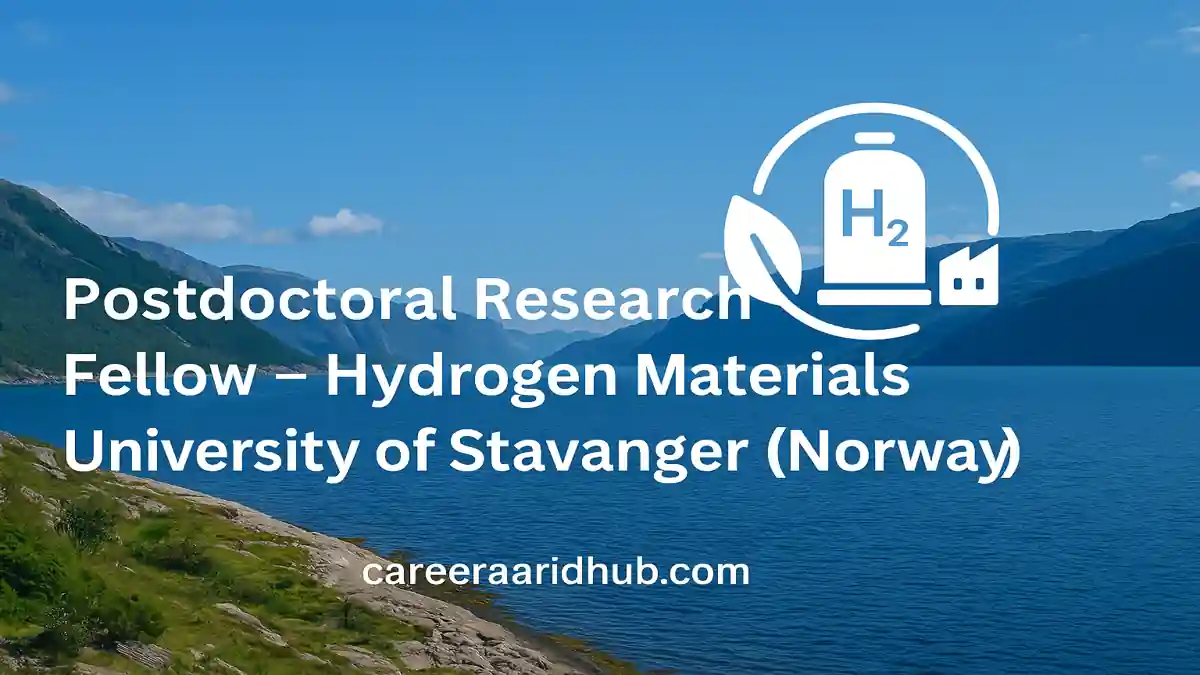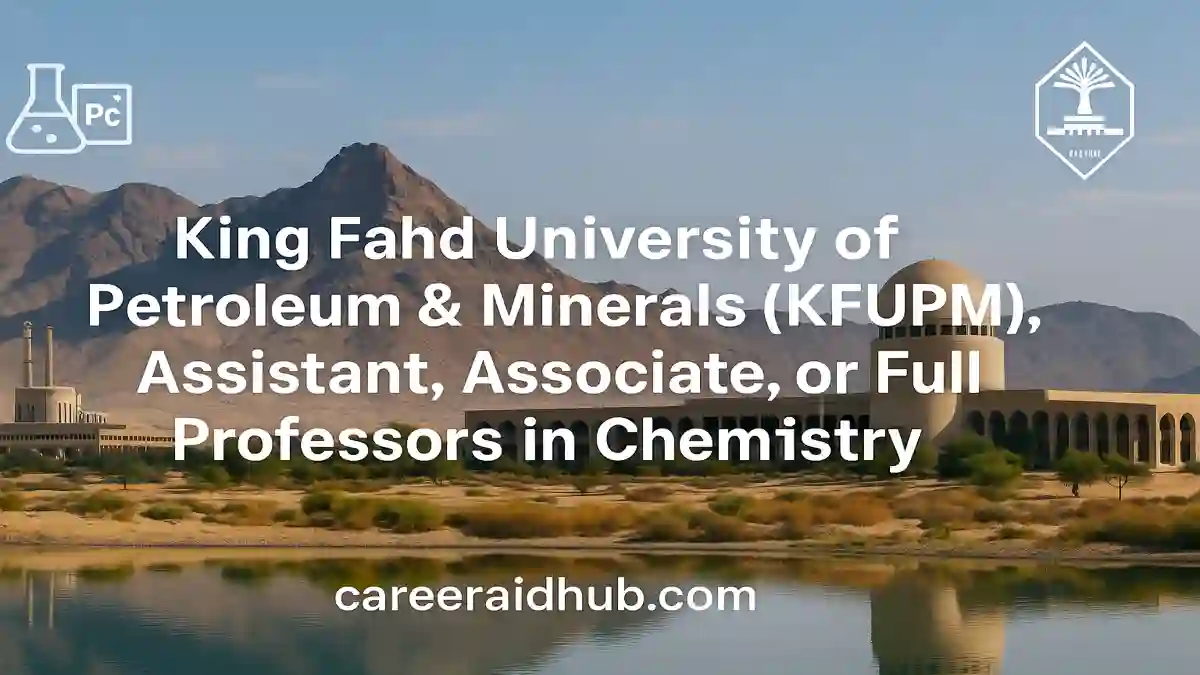Why University of Stavanger for Hydrogen Materials?
The University of Stavanger offers a strong, interdisciplinary ecosystem in energy and advanced materials. Researchers work across hydrogen storage, separation and purification, safety, and systems engineering—often in collaboration with national and international partners. This cross-pollination fosters novel materials discovery, rigorous characterization, and pragmatic translation from lab insights to device- and system-level impact.
Launch your next chapter in hydrogen science at the University of Stavanger (UiS). This in-depth guide explains the role, research themes, eligibility, and application strategy for a Postdoctoral Research Fellow in Hydrogen Materials—plus practical tips, timelines, and resources to help you submit a compelling application.
A Deep Hydrogen Research Ecosystem
UiS groups contribute to materials for energy storage and conversion, including hydrogen-rich solids, adsorbents and membranes for gas purification, and catalysts for production pathways. Because these themes are mutually reinforcing, postdocs gain a broader toolbox and a network of collaborators beyond a single project. This environment supports high-quality publications, diversified skills, and clear research narratives.
Separation, Storage, and Safety—A Balanced Portfolio
Hydrogen separation and purification naturally complement solid-state storage and safety research. Separation projects test permeance, selectivity, and process integration (e.g., PSA cycles), while storage efforts examine thermodynamics, kinetics, and cyclability in hydrides or porous frameworks. Safety
National Momentum and Industry Interface
Norway’s energy landscape creates fertile ground for hydrogen innovation. UiS teams often intersect with research schools and industry initiatives, enabling access to instrumentation, shared facilities, and translational pathways. Consequently, you can situate your materials work within credible use cases, making manuscripts more persuasive and grant proposals more competitive.
Role Overview: What “Hydrogen Materials” Usually Covers at UiS
While each call defines its own scope, most Postdoctoral Research Fellow – Hydrogen Materials roles include four pillars: targeted materials design, advanced characterization, device/process linkages, and collaboration & dissemination.
Materials Design & Synthesis
Expect to synthesize metal hydrides, hydrogen-rich alloys, porous adsorbents, or polymer/ceramic membranes. You may also tailor catalyst supports for production routes. Crucially, the role values hypothesis-driven experimentation—connecting composition and microstructure to storage capacity, rate processes, or membrane transport.
Characterization & Property Testing
You will likely employ XRD, SEM/TEM, BET, TGA/DSC, TPD/TPR, gas sorption isotherms, and permeability/selectivity rigs. Where feasible, in-situ and in-operando methods illuminate mechanisms under realistic conditions. Beyond raw data, committees look for robust analysis pipelines, uncertainty quantification, and reproducibility.
Device/Process Linkages
A hallmark of competitive applications is competency in translating materials data to separation or storage modules. For example, link permeance/selectivity to membrane area and purity targets;
Collaboration & Dissemination
Interdisciplinary teamwork is a core expectation. Postdocs often mentor MSc/PhD students, coordinate with safety or process engineers, and present results at project meetings and conferences. Clear, audience-appropriate communication accelerates both impact and adoption.
Eligibility & Ideal Profile
Selection committees typically prize three attributes: fit, rigour, and trajectory. While requirements vary by call, the following profile commonly succeeds.
Core Qualifications
-
- Doctorate in materials science, chemistry, chemical engineering, physics, or a closely related field with a clear hydrogen angle.
- Peer-reviewed outputs in relevant subfields (e.g., hydrides, membranes, adsorbents, catalysts, electrolyzers/fuel cells, gas separation).
- Experimental fluency across synthesis and characterization, ideally with pressurized gases or hydrogen-handling experience.
Desirable Experience
-
- Evidence of end-to-end project execution, from design and fabrication to property testing and modeling.
- Mentoring experience (e.g., supervising students, organizing lab workflows) and collaboration across labs or institutions.
- Familiarity with safety protocols (HAZOP, SOPs, risk assessments) for high-pressure hydrogen systems.
- Awareness of Norwegian postdoc timing rules or limits on prior postdoctoral periods.
What You’ll
Work On: Thematic Examples
To help you assess alignment, here are typical themes you may encounter.
Hydrogen Separation & Purification
Projects often target high-purity output from mixed gas streams. You may optimize membrane chemistry and structure to improve selectivity and flux under realistic temperatures and pressures, or design PSA cycles that balance recovery, purity, and energy intensity. Linking laboratory metrics to process KPIs will be central.
Hydrogen Storage in Solids
Storage projects investigate structure–property relationships in hydrogen-rich materials. You may map how alloying, nanostructuring, or defect engineering alter capacity, plateau pressures, and de/hydrogenation kinetics. Cycling stability and degradation analysis—supported by microscopy and spectroscopy—anchor the path from promising materials to durable subsystems.
Safety & Systems Thinking
Materials performance must coexist with safe operation. Projects may require integrating risk models, failure modes, and regulatory considerations into design choices. Documenting safety cases strengthens both scientific credibility and technology readiness.
The Research Environment
UiS’s research culture rewards curiosity, rigor, and collaboration. Facilities for materials synthesis, gas sorption, and microstructural analysis support fast iteration and systematic studies. Because teams regularly partner with national centers and industry, you will find natural
Interdisciplinary Supervision
Supervision frequently spans chemistry, materials physics, process engineering, and safety science. This model encourages a shared vocabulary across disciplines, enabling you to frame research questions that matter—from fundamental mechanisms to system performance.
Core Facilities and Shared Platforms
Beyond standard characterization suites, many projects leverage shared labs for gas-handling, membrane testing, or thermal analysis. When you discuss prior experience, emphasize instrumentation you can immediately operate and methodologies that raise the lab’s capability ceiling.
How to Apply (and What to Prepare)
A competitive dossier is concise, targeted, and verifiable. Use the official UiS portal to submit all materials; each call prescribes the exact list. Nevertheless, the following components recur.
Document Checklist
-
- Cover Letter: Map your expertise to the specific theme (e.g., membranes vs. storage). Frame 2–3 problem statements you can tackle in the first 6–12 months.
- Curriculum Vitae: Highlight first/corresponding-author papers, invited talks, data/code repositories, and instruments you can bring up quickly.
- Research Statement (1–3 pages): Define hypotheses, methods, expected results, and risk mitigation. Propose a milestone plan (e.g., month 3: reproduce baseline; month 9: deliver comparative dataset; month 18: submit two manuscripts).
- Degree Certificates & Transcripts: Provide certified copies per Norwegian norms.
- References: Line up referees who can attest to experimental rigor, independence, teamwork, and communication.
Application Tips
-
- Mirror the call’s language in moderation to show alignment without copying.
- Quantify accomplishments (e.g., “reduced activation energy by 15%,” “tripled hydrogen flux at 350 °C”).
- Show reproducibility practices: pre-registered protocols, version-controlled notebooks, raw-data sharing, or inter-lab validation.
Selection Criteria & What Hiring Committees Look For
Committees evaluate potential and fit as much as past achievements. They typically weigh:
Methodological Strength
Strong candidates articulate why a technique is chosen, how data are validated, and where uncertainty lies. Clear error analysis and protocol versioning inspire confidence.
Fit to Project Scope
If the call emphasizes gas separation, lead with permeance/selectivity, transport models, and module design. If it targets storage, foreground thermodynamics, kinetics, and cycling durability—plus heat management and scaling considerations.
Publication Quality & Trajectory
A focused set of high-impact articles often outperforms a diffuse list. Emphasize coherence: how your work evolves toward increasingly consequential questions.
Collaboration, Supervision, and Communication
Evidence of mentoring, cross-lab work, and precise scientific writing signals that you will accelerate team progress, not just your own.
Practical Tips for a Strong Application
Translate your experience into UiS’s context with these actionable tactics.
Align to UiS Themes
Use project-relevant terms such as permeance/selectivity, PSA cycle design, diffusivity/thermodynamics in hydrides, or degradation pathways. Then, connect each term to a specific result you have delivered.
Demonstrate End-to-End Thinking
Tie materials metrics to device or system KPIs: purity thresholds, recovery rates, energy intensity, cycle life, or safety margins. This narrative shows that you can convert data into design choices.
Map Collaborations Deliberately
Identify UiS groups you would interact with—materials physics, chemistry/biochemistry, process/safety. Propose at least one shared experiment or dataset you could co-develop within the first year.
Emphasize Safety and Standards
Detail your experience with high-pressure hydrogen, leak detection, purging protocols, or relevant standards. Safety literacy shortens onboarding time and lowers project risk.
Living and Researching in Stavanger
Stavanger blends an energy-sector heritage with a clean-tech future. Researchers benefit from stable funding structures, family-friendly policies, and a vibrant outdoor culture. For each vacancy, confirm the salary scale, contract length, and start date in the live advertisement; these vary by project and budget line.
Practical Settling-In Notes
-
- Investigate housing options early—university channels and local listings fill quickly ahead of the academic year.
- Explore public transport discounts and bike-friendly routes for an easy commute.
- Review Norwegian tax and social benefits to understand net income and entitlements.
Where to Find the Official Call
Always begin at the UiS Vacant Positions portal and filter for postdoctoral roles in relevant departments (e.g., Chemistry; Bioscience and Environmental Engineering; Materials Physics; Safety, Economics and Planning). Previous UiS calls in hydrogen topics—spanning separation/purification and safety—illustrate the language, requirements, and methods you are likely to encounter.
Program Snapshot
|
Feature |
Details |
|
Program Name |
Postdoctoral Research Fellow – Hydrogen Materials |
|
Host Country |
|
|
Funded By |
University of Stavanger (and associated project grants) |
|
Duration |
Typically 2–3 years (project-dependent) |
|
Study Mode |
Full-time, on-site |
|
Eligibility |
PhD in materials/chemistry/chem-eng/physics or closely related field; hydrogen-relevant research profile |
|
Financial Support |
Competitive university salary scale; social benefits per Norwegian regulations |
|
Fields of Study |
Hydrogen storage, separation/purification (membranes/adsorbents), catalysts, safety/systems |
|
Deadline |
Next cycle expected Mar 2026 — we will update soon |
|
Official Website |
Dates note: Based on recurring Norwegian academic recruitment patterns, hydrogen-materials posts at UiS are commonly advertised in late winter to spring. Consequently, the next cycle is anticipated in Mar 2026 (month/year only). Timelines will be monitored and updated soon after confirmation.
Conclusion
A postdoctoral fellowship in Hydrogen Materials at UiS is ideal for researchers who can move fluently from synthesis and characterization to process-aware design and safety-conscious deployment. If you pair experimental depth with clear, system-level storytelling, you will resonate with UiS’s collaborative research culture—and position yourself for meaningful impact in the hydrogen economy.
Official citation (conclusion): Explore UiS’s materials-focused research landscape to gauge group fit and collaboration opportunities. (https://www.uis.no/en/research/mathematics-and-natural-science/materials-physics)
Frequently Asked Questions (FAQs)
Typically, you design, synthesize, and characterize hydrides, membranes, or adsorbents; then, you link material properties to system performance, such as purity, recovery, efficiency, and durability.
Demonstrate hydrogen-handling safety, advanced characterization (XRD, SEM/TEM, sorption), membrane or hydride kinetics, and clear data analysis. Moreover, show reproducibility, collaboration, and concise scientific communication.
Competition is strong. However, you can stand out with focused publications, method depth, measurable outcomes, and a proposal directly aligned with the advertised project’s objectives and deliverables.
Preferably, yes. Additionally, show familiarity with high-pressure protocols, leak testing, purge procedures, and risk assessments to shorten onboarding and strengthen project safety cases.
Prepare a tailored cover letter, CV with publications, concise research plan, degree certificates, and referees. Furthermore, quantify achievements and match terminology to the specific call.
Generally, yes. Nevertheless, verify degree equivalence, relocation readiness, and any residence or work permit requirements, ensuring you can start within the project’s funding window.
They value reproducible datasets, well-reasoned methods, and targeted publications. In addition, connect materials metrics to process KPIs—purity, energy intensity, and cycle life—for tangible impact.
Expect interdisciplinary supervision and industry or national partnerships. Consequently, you can co-author papers, share facilities, and co-develop datasets that accelerate publication and translation.
Calls commonly appear around late winter to spring. Therefore, monitor the official vacancies portal and set alerts; then, update application materials proactively.
Premium Mentorship for a Stronger Application
- Premium Mentorship: personalised 1:1 guidance for this and similar opportunities
- In-depth review of your CV, academic profile, and key statements
- Aligned with international selection criteria so your profile matches what panels expect
- Stronger, more compelling narrative for highly competitive calls
- Step-by-step support from opportunity mapping to final submission (fee-based)










